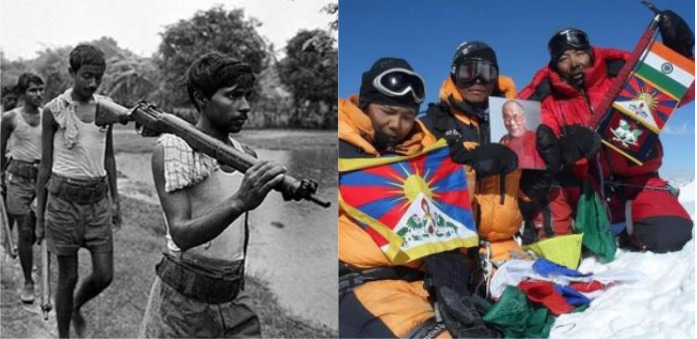Sino-India tensions have entered a new phase of escalation with reports of ‘warning shots’ being fired at the Line of Actual Control (LAC) in Eastern Ladakh and China kidnapping five Indian nationals from India’s Arunachal Pradesh. India is now feeling constrained to make the big move- reigniting the Tibet liberation movement.
BREAKING: First Official Statement from India on fresh LAC standoff with Chinese PLA & firing. ‘At no stage has Indian Army transgressed across the LAC or resorted to use of any aggressive means, including firing.’ India accuses China of firing to intimidate Indian troops at LAC. pic.twitter.com/OWsnRHwHAW
— Aditya Raj Kaul (@AdityaRajKaul) September 8, 2020
India is turning the tide by deploying the Special Frontier Force (SFF), a covert commando force recruiting heavily from Tibetan highlanders–that also played a role in liberating Bangladesh from Pakistan–at the LAC in Eastern Ladakh amidst the ongoing face-off with the Chinese PLA. The message is loud and clear- if India could use the SFF to free Bangladesh from Pakistan’s clutches in 1971, then New Delhi can also use it to free Tibet from Chinese occupation.
Bangladesh and Tibet continue to represent similar situations of decades of repression and forceful occupation in India’s neighbourhood. While Bangladesh (then ‘East Pakistan’) was a case of imposing Punjabi Muslim culture and Urdu upon the Bengali culture and language, the Buddhist kingdom of Tibet is facing decades of Communist invasion and domination by the Han Chinese culture.
When it comes to Pakistan and Bangladesh, at least Islam had linked them. But a Communist China is completely incongruent with a Buddhist Tibet. There is absolutely nothing to link ethnic Tibetans with the Han Chinese who are being flooded into Tibetan settlements by Beijing.
Also, the refugee situation is quite similar. Pakistan Army’s Operation Searchlight in the then East Pakistan–a genocide and mass rape of Bengali Muslims had created ten million refugees who fled into India. Tibet’s refugee situation is similar and in fact, older than the Bengali refugee situation.
For Tibetan Buddhists, it all started in 1951, when China annexed it surreptitiously. By 1959, Mao’s China made its intention of murdering Tibetan Buddhists and insulting the Dalai Lama clear. And this was when the Dalai Lama was forced to seek refuge in India, along with hundreds of thousands of other ethnic Tibetans whose ancient homeland was now occupied by a Communist-expansionist State called the People’s Republic of China.
India’s own strategic view of Tibet and Bangladesh is also not very different. In Bangladesh’s case, it was always a better option to have a secular, democratic Bangladesh towards India’s Eastern periphery than having an Islamist Terror State like Pakistan who train guns at India on both the Western borders and the Eastern borders.
When it comes to Tibet, the strategic disadvantage with Chinese occupation is even more apparent. India shares Himalayan border disputes with China only because Beijing has occupied Tibet. Had Tibet remained an independent country, India would have shared peaceful and open borders with Tibet as against a hostile border with China.
China isn’t even India’s neighbour and in its original shape, it would be nothing more than an extended neighbour of New Delhi. We had to fight a war and border skirmishes with China only because China reached the Eastern Himalayas by overwhelming Tibet. If Tibet regains its independent status, a hostile Sino-India border would cease to exist.
In fact, for a long time through the 1960s, Tibet was high on the Indo-American agenda. However, later there was a rapprochement between the US and China which led to Tibet becoming a secondary or almost a non-issue for the rest of the world.
But now, times seem to be changing again. As such, the contribution of SFF that functions under the Directorate General of Security (DGS) – a wing of India’s external intelligence agency R&AW is being acknowledged by India. New Delhi is telling the world that the cause of Tibetan liberation had taken a backseat, but, it didn’t die out. China still oppresses Tibetans and Buddhist monks murdering many of them and still driving many others to immolate themselves.
All this while, the SFF, which was formed with assistance from the CIA wasn’t being used for its original purpose. However, it does have the requisite experience of driving out invaders. In 1971, the SFF was instrumental in helping the Mukti Bahini to fight the Pakistan Army. As such, this Tibetan-dominated force intruded into what was called East Pakistan at the time under the cover of the Mukti Bahini.
The SFF and Mukti Bahini were solely responsible for the liberation of the Chittagong Hill tract during the historic war.
Do you know #Bangladesh Mukti Bahini was trained by India at #SFF training centre in #Chakrata area of #Uttarakhand during '71 war#IndiaChinaBorderTension pic.twitter.com/GkXDQBawGy
— Neeraj Rajput (@neeraj_rajput) September 2, 2020
The SFF is now finally getting to fight the battle for which it was actually raised- wresting Chinese occupation of Tibet. The top-secret force that liberated Bangladesh can now, therefore, liberate Tibet.
